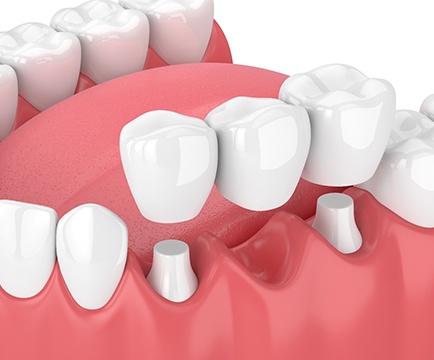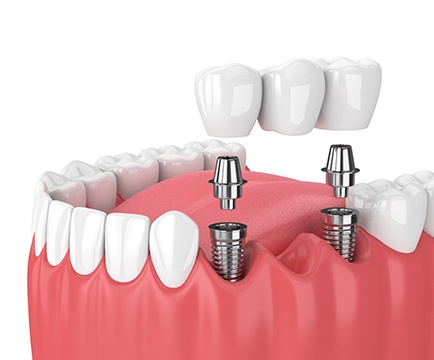No one wants to be missing a tooth, but thanks to modern dentistry you always have several smile solutions. When you are missing one or a few consecutive teeth but your teeth on either side of the gap are healthy, a dental bridge definitely merits consideration. At Baltimore Dental Arts, count on our dentists to confidently bridge the gap in your smile to restore its appearance and balance, plus this restoration will prevent dental drift and reduce your risk of gum disease. Contact your dentist in Baltimore to schedule a consultation!
What Is a Dental Bridge?

Dental bridges are designed to help patients who are missing one tooth or several teeth in a consecutive row. An alternative to partial dentures, this tried-and-true tooth-replacement solution uses dental crowns or dental implants to secure the pontics (free-standing replacement teeth) in place. Since the materials used are available in a wide range of lifelike shades, modern dental bridges fill the gap in your smile seamlessly. Plus, they are incredibly durable, ensuring your bite doesn’t suffer either!
Types of Dental Bridges
The first step to regaining your primetime grin is a consultation with our experienced dentist. They’ll conduct an oral examination, ask about your goals, and review your medical history. Based on their findings, one of the following treatment options will be recommended:
Traditional Dental Bridge

A traditional dental bridge can replace a single missing tooth or several teeth in a row. This restorative treatment requires you to have a natural, stable adjacent tooth in front of and behind the space that you’re wanting to fill in. Essentially, we’re “bridging in the gap” by making a single unit of three or more teeth.
Implant Bridge

As the name implies, an implant bridge uses dental implants as opposed to crowns. The implants are placed on either side of the gap in your smile, and after they’ve fused with the jawbone, we’ll be able to attach the dental bridge to the implants to replace two or more missing teeth. Considered the strongest and most stable system, an implant-supported bridge requires surgery to embed the implants into the jawbone. Your time invested in this option will pay off in the quality of the result!
The Benefits of Getting a Dental Bridge

When you replace your missing teeth with a dental bridge in Baltimore, you can expect to enjoy an array of benefits including:
- Maintained alignment of your existing teeth
- Improved oral health
- Easy cleaning and maintenance
- Jawbone preservation with implant bridges
- Long-lasting results (15 years with traditional & 35+ with implant-supported)
- Natural-looking smile
Dental Bridge FAQs

Ready to confidently bridge the gap in your smile? While dental bridges in Baltimore are a very common option for replacing missing teeth, it’s only natural to have some questions. We want you to always feel confident and well-informed about any treatment you choose, which is why we’ve gathered some commonly asked questions about dental bridges below! If you don’t see the answers you’re looking for, don’t hesitate to
give us a call
and we’ll be happy to help!
Learn More
Should I Get a Traditional Bridge or an Implant Bridge?
The answer to this question depends entirely on the unique needs and preferences of each patient. A traditional bridge requires less time, money, and effort to get, but won’t last as long as an implant bridge. On the other hand, an implant bridge may be more expensive and require minor oral surgery, but the results can last a lifetime, plus it will stimulate the jawbone! During your consultation, we’ll fully explain the pros, cons, and differences of each to help you discover which one is best for your situation.
Can You Take a Dental Bridge Out?
In short, no. Dental bridges are not meant to be taken out once bonded in place. Both traditional dental bridges and implant bridges are designed to stay in place unless removed by a dental professional. You shouldn’t be able to remove it on your own, nor should your dental bridge ever feel loose or wobbly. If your dental bridge falls out, contact us right away!
Is Getting a Dental Bridge Painful?
For a traditional dental bridge, a thin layer of enamel needs to be removed from the teeth on either side of the gap in your smile. We’ll thoroughly numb your mouth to ensure this step is virtually painless. Once the bridge is in place, you may feel some slight sensitivity for a few days.
Implant bridges require minor oral surgery to place. During the surgery, powerful numbing medication will ensure that you don’t feel any discomfort. Afterwards, you’ll go through a short recovery period that can involve slight swelling, bruising, and bleeding.
How Long Does a Dental Bridge Last?
The lifespan of a dental bridge will depend on the material it’s made of, where in the mouth its placed, and how well you take care of it. In general, a dental bridge will last between 5 and 15 years before needing to be replaced. You can make the most out of your dental bridge by avoiding bad chewing habits like biting your nails, chewing on ice, and using your teeth to open packages. You should also limit eating hard or sticky foods that could dislodge your dental bridge, and you need to practice great oral hygiene to ensure no issues develop.
Can a Dental Bridge Be Whitened?
Dental bridges cannot be whitened, even with professional teeth whitening. This is because, unlike natural teeth, they’re made of non-porous material. While this helps to make them stain-resistant, it also makes them impervious to whitening treatments. If you plan on having your teeth whitened soon, consider doing so before getting your dental bridge. That way, we can match the color of your dental bridge to your newly brightened smile.
 Formerly Conklin & Ward Dental Group
Formerly Conklin & Ward Dental Group




